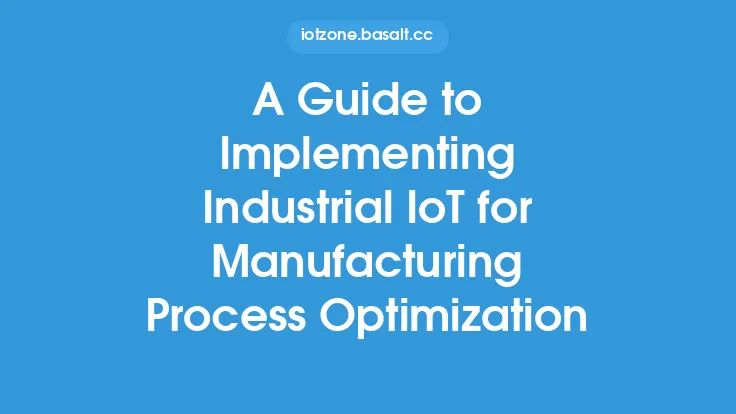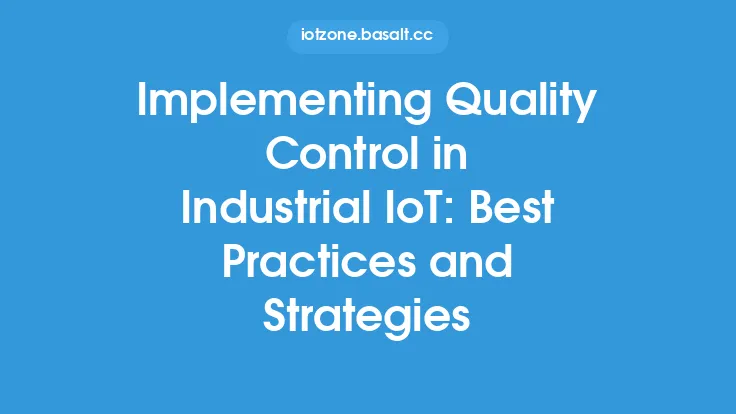The increasing awareness of environmental issues and the need for sustainable practices has led to a significant shift in the manufacturing sector. Companies are now focusing on reducing their carbon footprint, minimizing waste, and optimizing resource utilization. The Industrial Internet of Things (IIoT) has emerged as a key enabler of sustainable manufacturing practices, offering a wide range of benefits that can help companies achieve their environmental goals. In this article, we will explore the ways in which IIoT can be leveraged to promote sustainable manufacturing practices, and discuss the various technologies and strategies that are being used to achieve this objective.
Introduction to Sustainable Manufacturing
Sustainable manufacturing refers to the production of goods and services in a way that minimizes environmental impact, conserves resources, and promotes social responsibility. This approach involves the use of environmentally friendly materials, reduction of waste and emissions, and the implementation of energy-efficient processes. Sustainable manufacturing is not only beneficial for the environment, but it also offers several economic benefits, such as reduced costs, improved brand reputation, and increased customer loyalty. The IIoT has emerged as a key driver of sustainable manufacturing, enabling companies to optimize their processes, reduce waste, and improve resource utilization.
Role of IIoT in Sustainable Manufacturing
The IIoT plays a critical role in sustainable manufacturing by providing real-time data and insights that can be used to optimize processes, reduce waste, and improve resource utilization. IIoT devices, such as sensors and actuators, can be used to monitor and control various aspects of the manufacturing process, including energy consumption, water usage, and waste generation. This data can be used to identify areas of inefficiency and implement corrective actions, such as optimizing production schedules, reducing energy consumption, and implementing waste reduction programs. Additionally, IIoT devices can be used to monitor and control the condition of equipment, reducing the need for maintenance and minimizing downtime.
Technologies Used in IIoT-Enabled Sustainable Manufacturing
Several technologies are being used to enable IIoT-based sustainable manufacturing, including:
- Sensor technologies: Sensors are used to monitor various aspects of the manufacturing process, including temperature, pressure, vibration, and energy consumption. This data is used to optimize processes, reduce waste, and improve resource utilization.
- Cloud computing: Cloud computing is used to store and analyze the vast amounts of data generated by IIoT devices. This data is used to identify trends, optimize processes, and predict maintenance needs.
- Artificial intelligence (AI) and machine learning (ML): AI and ML are used to analyze data from IIoT devices and identify areas of inefficiency. This data is used to optimize processes, reduce waste, and improve resource utilization.
- Industrial automation: Industrial automation is used to control and monitor various aspects of the manufacturing process, including production schedules, energy consumption, and waste generation.
Benefits of IIoT-Enabled Sustainable Manufacturing
The benefits of IIoT-enabled sustainable manufacturing are numerous, and include:
- Reduced energy consumption: IIoT devices can be used to monitor and control energy consumption, reducing waste and minimizing the environmental impact of manufacturing processes.
- Minimized waste generation: IIoT devices can be used to monitor and control waste generation, reducing the amount of waste sent to landfills and minimizing the environmental impact of manufacturing processes.
- Improved resource utilization: IIoT devices can be used to monitor and control resource utilization, reducing waste and minimizing the environmental impact of manufacturing processes.
- Increased efficiency: IIoT devices can be used to optimize processes, reducing downtime and increasing productivity.
- Cost savings: IIoT-enabled sustainable manufacturing can help companies reduce costs, improve efficiency, and increase profitability.
Implementation of IIoT-Enabled Sustainable Manufacturing
The implementation of IIoT-enabled sustainable manufacturing requires a strategic approach, and involves several steps, including:
- Assessment of current processes: Companies must assess their current processes and identify areas of inefficiency and waste.
- Selection of IIoT devices: Companies must select the IIoT devices that are best suited to their needs, including sensors, actuators, and other devices.
- Implementation of IIoT devices: Companies must implement IIoT devices and integrate them with existing systems and processes.
- Analysis of data: Companies must analyze the data generated by IIoT devices and use it to optimize processes, reduce waste, and improve resource utilization.
- Continuous monitoring and improvement: Companies must continuously monitor and improve their processes, using data from IIoT devices to identify areas of inefficiency and implement corrective actions.
Challenges and Limitations of IIoT-Enabled Sustainable Manufacturing
While IIoT-enabled sustainable manufacturing offers several benefits, there are also several challenges and limitations that must be addressed, including:
- High upfront costs: The implementation of IIoT devices and systems can be expensive, and may require significant upfront investment.
- Complexity of IIoT systems: IIoT systems can be complex and difficult to implement, requiring specialized expertise and knowledge.
- Cybersecurity risks: IIoT devices and systems can be vulnerable to cybersecurity risks, including hacking and data breaches.
- Data management: The vast amounts of data generated by IIoT devices can be difficult to manage and analyze, requiring specialized expertise and knowledge.
Conclusion
In conclusion, IIoT-enabled sustainable manufacturing offers several benefits, including reduced energy consumption, minimized waste generation, improved resource utilization, increased efficiency, and cost savings. The implementation of IIoT-enabled sustainable manufacturing requires a strategic approach, and involves several steps, including assessment of current processes, selection of IIoT devices, implementation of IIoT devices, analysis of data, and continuous monitoring and improvement. While there are several challenges and limitations that must be addressed, the benefits of IIoT-enabled sustainable manufacturing make it an attractive option for companies looking to reduce their environmental impact and improve their bottom line. As the manufacturing sector continues to evolve, it is likely that IIoT-enabled sustainable manufacturing will play an increasingly important role in promoting environmental sustainability and reducing waste.





